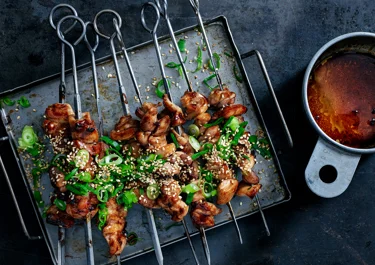Yakitori

Try your hand at our yakitori recipe, where juicy chicken skewers meet a glossy glaze of soy sauce, ginger, honey, chilli, and garlic. They are cooked under high heat, brushed until sticky and glossy, and finished with spring onions and sesame seeds. Prepare yourself for slightly messy fingers as you enjoy the fun that comes with these deliciously sticky skewers.
Ingredients
|
Chicken thigh fillets
|
450 g |
|---|---|
|
Garlic clove
|
1 |
|
Red chilli
|
½ |
|
Fresh ginger, finely grated
|
1 tbsp |
|
Japanese soy sauce (unsalted)
|
75 ml |
|
Rice vinegar
|
50 ml |
|
Sesame oil
|
3 tbsp |
|
Honey
|
1 tbsp |
|
Salt
|
|
|
Black pepper
|
|
|
Grill skewers
|
8 |
Garnish
|
Spring onions
|
1 bunch |
|---|---|
|
Sesame seeds, toasted
|
15 g |
Instructions
Recommended information
Serving suggestion
Remember to soak the skewers
If you are using wooden skewers, give them a good soak in water for at least 30 minutes before placing them in the oven. It stops them from drying out or burning during cooking.
Simmer longer for a thicker glaze
Let the sauce simmer 5–10 minutes longer than the suggested 25 minutes if you prefer a thicker glaze. The longer it bubbles away, the glossier and stickier it becomes, making it cling to the chicken even better.
FAQ: Questions about yakitori
If yakitori has caught your attention, but you still have a few questions, we have got you covered. Everything you need to know is answered just below.
What is yakitori?
Yakitori is a classic Japanese way of cooking skewered chicken, usually over a charcoal grill. The name means “grilled bird,” and it sticks to that idea, using everything from thighs and breasts to hearts and gizzards. It is usually seasoned with either salt or a glaze called tare, made from soy sauce, mirin, sake, and sugar. You will find yakitori at festivals, sizzling in street stalls, or served in izakaya (Japanese pubs) and yakitori joints.
How is yakitori traditionally cooked?
Yakitori is traditionally grilled over charcoal on small, portable grills, often used by street vendors in yatai stalls. The high heat from the charcoal cooks the chicken quickly and gives it its signature smoky flavour. The meat is cut into evenly sized pieces, threaded onto bamboo skewers, and grilled over the flames until lightly charred and cooked through.
Can I make yakitori without a grill?
Of course! Yakitori can easily be made without a grill. Use your oven’s grill setting to get similar results. Place the skewers on a rack with a tray underneath to catch any drips, and position them near the top of the oven where the heat is strongest – keep an eye on them the whole time. Brushing on layers of sauce as they cook helps build that sticky glaze, just like you would on a charcoal grill.
How to store and reheat yakitori?
Store leftover yakitori in an airtight container in the fridge for up to 3 days. If you want to store it for longer, you can freeze it for 2 months, also in an airtight container. To reheat, simply place the skewers on a baking tray and warm them in the oven at 180 °C for about 10 minutes. You can also use a frying pan over medium heat, turning the skewers until heated through. Avoid microwaving, as it can make the chicken chewy and the glaze lose its texture.
What to serve with yakitori?
Yakitori is often served with steamed rice, pickled vegetables, or light salads. Other popular sides include grilled onigiri, sesame noodles, sautéed bok choy, or a chilli oil cucumber salad. Choose sides that keep things light and let the skewers stay in focus.
Nutritional values
Nutritional value, per
1032 Kcal
| Fibre | 2.1 gram fibers |
| Protein | 92 gram |
| Carbohydrates | 22.3 gram |
| Fat | 64.2 gram |
Try our Japanese-inspired yakitori chicken skewers
In Japan, yakitori is a go-to favourite, with skewers of chicken sizzling over charcoal and brushed with a glaze until sticky and golden. Our Japanese-inspired recipe for chicken yakitori sticks to that familiar base of soy sauce, garlic, and ginger, the trio you will find almost everywhere yakitori is served.
We subtly update the recipe with a splash of sesame oil, honey, and sliced red chilli. It is not a reinvention but a respectful nod to the original with a few extras to introduce our personal touch. The result? Juicy and full-flavoured skewers that taste like tradition while giving you something new to enjoy.
After these yakitori, why not try something else with that same Japanese-inspired flair? Our teriyaki salmon noodles, aromatic yakiniku, and fresh sushi bowl are the perfect follow-up.
Glazed in a sweet and savoury sauce
The sauce really is as important as the chicken. Brushed on in layers, the glaze grips the meat and thickens as it cooks, turning glossy and sticky with each pass under the heat. It caramelises lightly at the edges, bubbles in spots, and settles into a shiny, lacquered finish.
The glaze builds on the salty, savoury soy sauce notes, which match the floral sweetness of honey wonderfully. Because a yakitori sauce needs exciting depth and complexity, we include the punchy edge of garlic, the fresh warmth of ginger, the tangy undertone of rice vinegar, and spicy chilli flakes.
Add a finishing touch with sesame seeds and spring onions
Once the skewers are cooked and glazed, it is time for a finishing touch. Toasted sesame seeds develop a more profound, nuttier crunch as their flavour unlocks in the pan. Finely sliced spring onions follow up with a sharp snap that enlivens the aromatic flavours with their cooling freshness. Both are classic Japanese garnishes, giving you that last bit of tasty tradition before you dig in.
Serve with tasty sides
Yakitori works brilliantly on its own, but it never hurts to serve a few sides alongside the skewers. Steamed rice is a go-to classic, especially for scooping up any leftover glaze. Pickled vegetables such as cucumber or red cabbage lean into the classic feel and help refresh the palate between skewers.
Daikon and carrot slaw with a light soy or miso-based dressing adds a nice crunch and sharpness to cut through aromatic flavours. No matter which sides you choose, the skewers are the star, with everything else happily following along.
Ideas for varying the recipe
Now is the time to get creative with this chicken yakitori recipe! If you prefer chicken breast over thigh fillets, it works just as well, though it might be a touch leaner, so be careful not to overcook it. Other meats like pork, beef, or tofu are all great options for switching up the skewers. Pork has a slightly sweeter, milder taste, while beef provides a richer, heartier flavour. Tofu absorbs the glaze like a sponge, giving a softer, creamier bite.
As for the glaze, use maple syrup instead of honey for a more robust sweetness. For a bit of fruity contrast, add some grated apple or pear. Apple is crisp and tart, while pear provides soft, floral notes. Although neither apple nor pear are traditional in yakitori, they are commonly used in Japanese cuisine to introduce a pop of fruity freshness to aromatic sauces.








